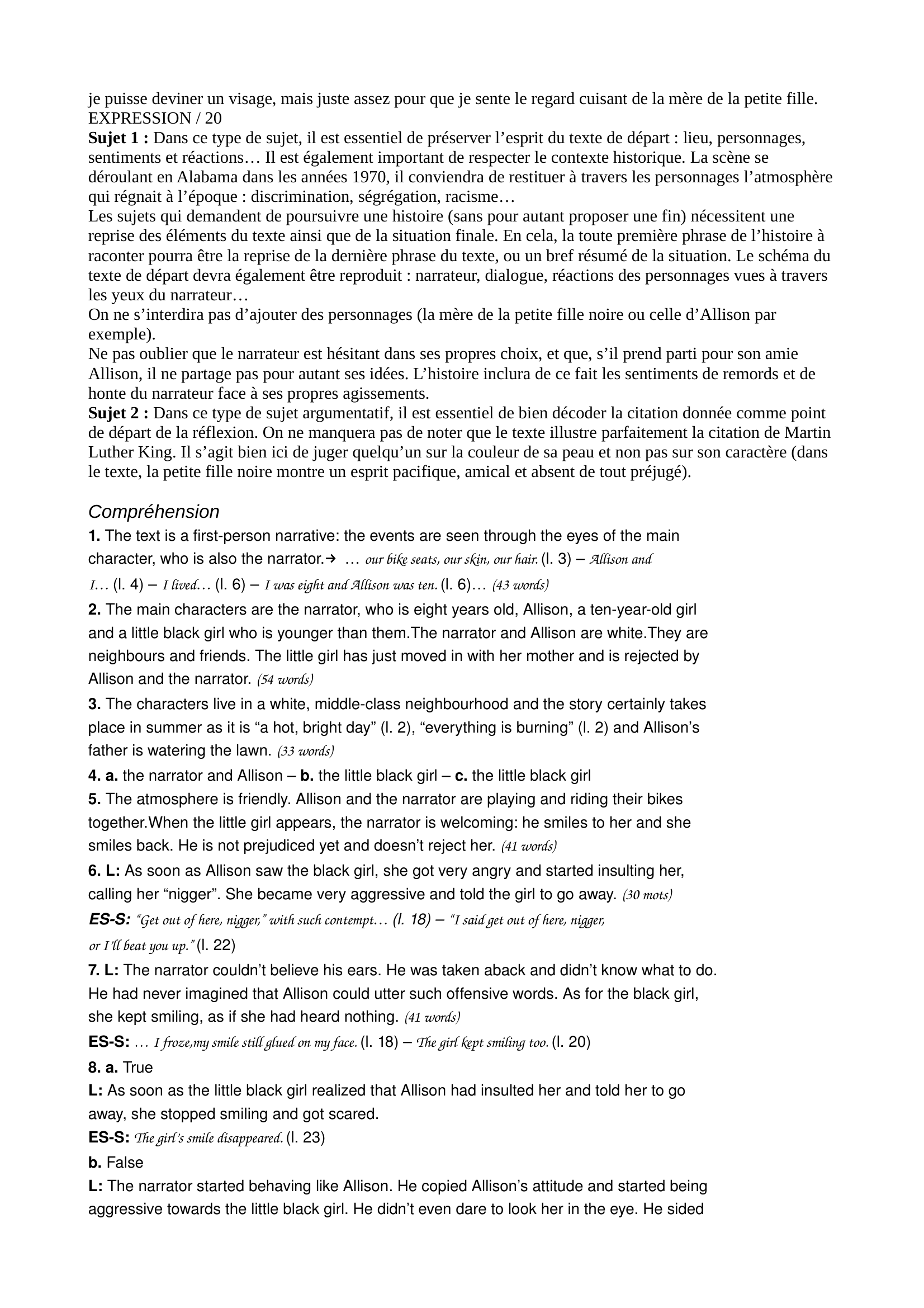anglais corrrigé de new girl
Publié le 29/06/2013

Extrait du document
«
je puisse deviner un visage, mais juste assez pour que je sente le regard cuisant de la mère de la petite fille.
EXPRESSION / 20
Sujet 1 : Dans ce type de sujet, il est essentiel de préserver l’esprit du texte de départ : lieu, personnages,
sentiments et réactions… Il est également important de respecter le contexte historique.
La scène se
déroulant en Alabama dans les années 1970, il conviendra de restituer à travers les personnages l’atmosphère
qui régnait à l’époque : discrimination, ségrégation, racisme…
Les sujets qui demandent de poursuivre une histoire (sans pour autant proposer une fin) nécessitent une
reprise des éléments du texte ainsi que de la situation finale.
En cela, la toute première phrase de l’histoire à
raconter pourra être la reprise de la dernière phrase du texte, ou un bref résumé de la situation.
Le schéma du
texte de départ devra également être reproduit : narrateur, dialogue, réactions des personnages vues à travers
les yeux du narrateur…
On ne s’interdira pas d’ajouter des personnages (la mère de la petite fille noire ou celle d’Allison par
exemple).
Ne pas oublier que le narrateur est hésitant dans ses propres choix, et que, s’il prend parti pour son amie
Allison, il ne partage pas pour autant ses idées.
L’histoire inclura de ce fait les sentiments de remords et de
honte du narrateur face à ses propres agissements.
Sujet 2 : Dans ce type de sujet argumentatif, il est essentiel de bien décoder la citation donnée comme point
de départ de la réflexion.
On ne manquera pas de noter que le texte illustre parfaitement la citation de Martin
Luther King.
Il s’agit bien ici de juger quelqu’un sur la couleur de sa peau et non pas sur son caractère (dans
le texte, la petite fille noire montre un esprit pacifique, amical et absent de tout préjugé).
Compréhension
1. The text is a firstperson narrative: the events are seen through the eyes of the main
character, who is also the narrator.
→ … our bike seats, our skin, our hair. (l. 3) – Allison and I… (l. 4) – I lived… (l. 6) – I was eight and Allison was ten. (l. 6)… (43 words) 2. The main characters are the narrator, who is eight years old, Allison, a tenyearold girl and a little black girl who is younger than them.The narrator and Allison are white.They are neighbours and friends. The little girl has just moved in with her mother and is rejected by Allison and the narrator. (54 words) 3. The characters live in a white, middleclass neighbourhood and the story certainly takes place in summer as it is “a hot, bright day” (l. 2), “everything is burning” (l. 2) and Allison’s father is watering the lawn. (33 words) 4. a. the narrator and Allison – b. the little black girl – c. the little black girl 5. The atmosphere is friendly. Allison and the narrator are playing and riding their bikes together.When the little girl appears, the narrator is welcoming: he smiles to her and she smiles back. He is not prejudiced yet and doesn’t reject her. (41 words) 6. L: As soon as Allison saw the black girl, she got very angry and started insulting her, calling her “nigger”. She became very aggressive and told the girl to go away. (30 mots) ESS: “Get out of here, nigger,” with such contempt… (l. 18) – “I said get out of here, nigger, or I’ll beat you up.” (l. 22) 7. L: The narrator couldn’t believe his ears. He was taken aback and didn’t know what to do. He had never imagined that Allison could utter such offensive words. As for the black girl, she kept smiling, as if she had heard nothing. (41 words) ESS: … I froze,my smile still glued on my face. (l. 18) – The girl kept smiling too. (l. 20) 8. a. True L: As soon as the little black girl realized that Allison had insulted her and told her to go away, she stopped smiling and got scared. ESS: The girl’s smile disappeared. (l. 23) b. False L: The narrator started behaving like Allison. He copied Allison’s attitude and started being aggressive towards the little black girl. He didn’t even dare to look her in the eye. He sided. »
↓↓↓ APERÇU DU DOCUMENT ↓↓↓
Liens utiles
- Expression écrite Anglais : London and New York, two global cities
- The New Girl
- New York (ville)1PRÉSENTATIONNew York (ville), en anglais New York City, ville du sud-est de l'État de New York, située dans le nord-est des États-Unis, à l'embouchure de l'Hudson, sur l'océanAtlantique.
- Nouvelle-Orléans, La 1 PRÉSENTATION Nouvelle-Orléans, La, en anglais New Orleans, ville du sud-est des États-Unis, située dans le sud-est de l'État de la Louisiane, sur le lac Pontchartrain et sur le Mississippi.
- THE NEW GIRL









